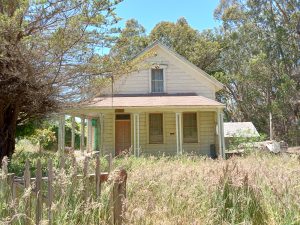When we left off last week, Footprints on the Mendocino Coast had John Simpson Ross hurrying to finish his house in Caspar before his family arrived from Canada. In mid-June of 1870, before the house was completely ready, Jane Ross and the three children (William, John, and Lizzie) and her aged parents, Ann and Robert Ralston, disembarked from the Cora down in Caspar Cove. Members of the traveling party were housed by three hospitable friends for a couple more weeks while the house was made habitable.

The Ross house may be old, but “its bones are still good,” according to a neighbor.
The land had to be rendered useful too and father-in-law Ralston was just the man for the task: “He was a great worker and a giant to wield an axe, and lost no time after his arrival.” Ralston and the Ross boys cleared the land around the house, “waging a steady war on brush and roots; their fires burned continuously.” They planted 18 apple seedlings for an orchard, but, “as the season was well advanced,” they were unable to plant a garden the first year. That was a source of concern for someone who relied on the kindness of strangers and the bounty of Mother Nature.
Having grown up poor and orphaned in Scotland, on the day the family moved into the house, Ross “was especially elated and joyful…to have a house of my own. I had never experienced that joy before. My memories … brought before me a tenant at the mercy of an arbitrary landlord, who could eject us at his pleasure. To me, the acquisition of a house was everything.”
In the spring on 1871, Ross was eager to plant a large garden and one of his congregants, a Mr. McPherson, owner of the Noyo and Albion mills, gave him three bags of seed potatoes. “We planted them and had a wonderful yield. They were tasteful and the most inviting I had ever seen.” Ross grew enough potatoes and other vegetables (beets, carrots, turnips, cabbage) to sell the surplus to the Caspar lumber company for the millworkers and the loggers in the inland camps. He estimated that he sold 20 tons of vegetables that year.
Two more Ross children were born in the early Caspar years—Robert Ralston (1872) and Anne (1874)—so the modest house must have been snug. Ross feared that, “The wild and reckless life on the frontier was unfavorable to the children. When he was absent (which was often) on preaching tours, “Mrs. Ross would take them out to orchard on the Lord’s day afternoons. This was more secluded than beside the road in front with the travelling public on the march.”
In 1883, John and Lizzie were sent off to Woodstock College, a Baptist institution in Ontario, Canada, from which they graduated in 1886 and returned to the Mendocino area. Nothing more about the house or the children is mentioned in Ross’ memoir, but we know from other sources that the kids all turned out OK. When Ross retired from active ministry in 1903, he and Jane moved to a ranch north of Cleone that had been homesteaded by Robert Ralston and William Ross in the 1880s.
What became of the Caspar house then I have yet to determine. The current owner has cleared out some old eucalyptus and cypress from the grove north of the house, but beyond that, nothing has been done to the 152-year-old house. When I learn more, you will be the first to know.
The July 4th party returns to the Kelley House lawn this year, so don’t miss it. Thursday through Sunday, the Kelley House is open from 11:00 AM to 3:00 PM. Contact us at info@kelleyhousemuseum.org to make an appointment, or just drop by. Walking tours of the historic district depart from the Kelley House regularly; for tour schedule, visit www.kelleyhousemuseum.org.